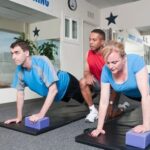How should my workout shoes fit is a common question among fitness enthusiasts, and for good reason. The importance of proper fitting workout shoes cannot be overstated when it comes to preventing injuries and ensuring comfort during physical activities. Ill-fitting shoes can lead to blisters, black toenails, discomfort, and even long-term foot issues. This article will delve into the key aspects of finding the right fit for your workout shoes to optimize your performance and protect your feet.
One of the first steps in ensuring that your workout shoes fit properly is understanding how to measure your feet accurately. The size of your feet can vary over time, so it’s essential to get an up-to-date measurement before purchasing new shoes.
Additionally, taking into account the width of your feet is crucial in finding a comfortable fit. Different brands and styles may have variations in sizing, so knowing the accurate measurements of both length and width can help you narrow down your options.
Another critical factor to consider is the arch of your foot. Whether you have high arches, flat feet, or neutral arches, understanding how your foot arch affects shoe fit is essential for choosing the right pair of workout shoes. Your foot arch plays a significant role in providing support and cushioning during physical activities, so selecting a shoe that complements your arch type is key to maintaining proper alignment and avoiding discomfort.
Finding the Right Size
To measure your feet accurately, start by tracing an outline of each foot on a piece of paper while standing up straight. Use a ruler to measure the length from the tip of your longest toe to the back of your heel.
It’s essential to measure both feet as they may differ slightly in size. When trying on shoes, make sure there is about a thumb’s width of space between the end of your longest toe and the tip of the shoe.
Another tip for finding the right size workout shoes is to consider the time of day you shop for them. Your feet tend to swell throughout the day, so it’s best to try on shoes in the afternoon or evening when they are at their largest size.
Remember that different brands may have slight variations in sizing, so it’s important to try on multiple sizes and styles to determine what fits best for you. By following these tips for measuring your feet accurately, you’ll be well on your way to finding workout shoes that fit perfectly and support you during all types of physical activity.
Understanding Foot Arch
When it comes to finding the perfect workout shoes, understanding your foot arch is crucial. The arch of your foot plays a significant role in determining how your shoes should fit and function during physical activity. There are three main types of foot arches: high, medium, and low arches. Each type requires different levels of support and cushioning in a shoe to provide optimal comfort and performance.
Here are some tips on how to determine your foot arch type:
- One way to identify your foot arch is by doing the wet test: Wet your feet and step on a piece of paper to see the imprint.
- If you have a high arch, you will notice a narrow imprint with a distinct curve along the inside of your foot.
- For individuals with low arches, the footprint will show almost the entire sole of the foot with minimal curve along the inside.
The right shoe for your foot arch can help prevent common issues like overpronation or supination during workouts. Overpronation occurs when the ankle rolls inward excessively, while supination involves an outward rolling motion. Both conditions can lead to discomfort, pain, and even injuries if not properly addressed with suitable footwear.
It is essential to choose workout shoes that offer adequate support for your specific foot arch type. Look for shoes with features such as arch support inserts or cushioning insoles designed to accommodate high, medium, or low arches. By selecting the right shoe based on your foot arch, you can enhance your overall comfort, performance, and reduce the risk of potential injuries during exercise sessions.
Toe Box Space
When it comes to workout shoes, having enough room in the toe box is crucial for overall comfort and performance during your exercise routine. The toe box is the front part of the shoe where your toes rest, and it should provide ample space for your toes to move freely without feeling cramped or restricted. Proper toe box space can prevent issues like blisters, calluses, and even more serious foot problems like bunions or ingrown toenails.
To ensure that your workout shoes have enough room in the toe box, there are a few key tips to keep in mind when trying on different pairs:
- 1. Stand up and wiggle your toes to see if there is enough space for movement
- 2. Make sure there is about a thumb’s width of space between the tip of your longest toe (usually the big toe) and the end of the shoe
- 3. Check for any pressure or tightness in the sides or top of the toe box as this can lead to discomfort during workouts
Having proper toe box space not only enhances comfort but also allows for better balance and stability during exercises that require quick movements or changes in direction. Remember that different shoe brands may have slightly different fits, so always prioritize finding a pair that offers adequate room for your toes to move comfortably as you work out.
Another important aspect related to toe box space is ensuring that there is enough room for your feet to naturally splay out while exercising. This natural widening of the foot upon impact helps with shock absorption and overall stability during activities like running or weightlifting.
If you feel any pinching or restriction in the toe area while wearing your workout shoes, it may be a sign that they are too small and could potentially lead to discomfort or injury over time.
Heel Support
Proper heel support in workout shoes is crucial for maintaining stability, reducing the risk of injuries, and ensuring overall comfort during physical activities. When considering how should my workout shoes fit, paying close attention to the support in the heel area is essential. The heel counter, which is the part of the shoe that wraps around the heel, should provide a snug fit without being too tight or too loose.
One important aspect of heel support is preventing slippage. Your heels should not lift up and down when walking or running in your workout shoes. This can lead to blisters and discomfort. Additionally, proper heel support helps distribute your body weight evenly throughout your foot, reducing strain on your muscles and joints.
To ensure you have adequate heel support in your workout shoes, look for styles with cushioning around the heel area and a firm heel counter that holds your foot securely in place. When trying on shoes, pay attention to how your heels feel in them. They should feel supported but not restricted. Taking the time to find workout shoes with proper heel support can make a significant difference in your overall performance and comfort during exercise.
| Heel Support | Proper Fit |
|---|---|
| Prevents slippage | Reduces risk of blisters |
| Distributes body weight evenly | Reduces strain on muscles and joints |
Width Matters
Finding the right width for your workout shoes is essential for comfort and performance during your exercise routine. So, how should my workout shoes fit in terms of width? The key is to ensure that your shoes are neither too narrow nor too wide. When trying on a pair of workout shoes, make sure there is no pressure on the sides of your feet, as this can lead to discomfort and potential injury.
One way to determine if your shoes are the correct width is by checking if there is enough space between the widest part of your foot (usually near the toes) and the edge of the shoe. Your toes should have some wiggle room without feeling cramped or restricted. Additionally, pay attention to any pinching or chafing around the ball of your foot or heel, as these are signs that the shoes may be too narrow or wide for you.
It’s also important to consider that different brands and shoe models may vary in terms of width, even if they are labeled with the same size. Don’t hesitate to try on multiple sizes and widths to find the best fit for your feet. Remember, a proper fitting workout shoe should feel snug yet comfortable, providing support without constricting movement.
| Width Considerations | Fit Indications |
|---|---|
| Toe Wiggle Room | No pinching at toes |
| Avoiding Side Pressure | No pressure on sides of feet |
| Sizing Variation | Different brands may vary |
Flexibility and Stability
When it comes to flexibility, you want a shoe that allows your foot to move naturally without feeling restricted. Look for workout shoes with features like flexible soles and breathable materials that will adapt to your movements. This will help prevent any discomfort or potential injuries while exercising, especially during activities that require a lot of motion like running or dancing.
On the other hand, stability is crucial for providing support and preventing injuries during high-impact workouts. Make sure your workout shoes have adequate cushioning and arch support to help absorb shock and distribute pressure evenly. A stable shoe should also have a firm heel counter to keep your foot in place and reduce the risk of rolling an ankle or experiencing pain in the heel area.
Ultimately, finding the right balance between flexibility and stability will depend on the type of workouts you do and your individual needs. Consider trying on different pairs of shoes and testing them out through various movements to see how they feel on your feet. Remember, it’s important that your workout shoes fit properly to ensure optimal performance, comfort, and injury prevention during exercise.
Trying Them On
When it comes to workout shoes, proper fit is essential to maximize comfort, performance, and prevent injuries. Here are some best practices for testing the fit of your workout shoes to ensure they are the right pair for you.
Comfort Is Key
One of the first things to consider when trying on workout shoes is comfort. The shoes should feel snug but not tight, with enough room for your toes to wiggle comfortably. Walk around in the shoes and pay attention to any areas that might feel too tight or loose. Your heels should also feel secure and supported without any slipping.
Proper Sizing
Always measure both of your feet before trying on workout shoes, as foot size can vary between each foot. Make sure there is about a thumb’s width of space between your longest toe and the end of the shoe. Remember that sizing may differ between brands, so don’t be afraid to try different sizes until you find the perfect fit.
Movement and Flexibility
When trying on workout shoes, test their flexibility by bending them at the ball of the foot. They should flex where your foot naturally bends during movement. At the same time, check for stability by rocking back and forth on your heels and toes. The right workout shoe will provide a balance between flexibility for movement and stability for support during various exercises.
Signs of Poor Fit
In conclusion, it is essential to pay close attention to how your workout shoes fit in order to ensure optimal performance and prevent injury. Finding the right size by accurately measuring your feet, understanding your foot arch, and allowing enough room for your toes are key factors in selecting the perfect pair of workout shoes. Proper heel support and determining the width that suits your feet are also crucial aspects to consider when choosing workout shoes.
When testing out potential workout shoes, remember to strike a balance between flexibility for movement and stability for support. This will not only enhance your performance during workouts but also reduce the risk of discomfort or pain. Pay attention to how the shoes feel on your feet, making sure they provide adequate support and comfort across different movements.
If you notice any warning signs that indicate your workout shoes are not fitting properly, such as blisters, calluses, or pain during exercise, it may be time to reassess their fit. Your workout shoes should feel snug yet comfortable, with ample cushioning and support for your specific needs. By following these guidelines on how should my workout shoes fit, you can ensure a more enjoyable and effective exercise experience while keeping your feet happy and healthy.
Frequently Asked Questions
Should Workout Shoes Be Tight or Loose?
Workout shoes should not be too tight or too loose. They should fit snugly around your feet to provide support and stability during exercise. A properly fitting workout shoe will prevent blisters, discomfort, and potential injuries.
How Do I Know if My Workout Shoes Are Too Small?
You can tell if your workout shoes are too small if you experience pain, discomfort, numbness, or tingling in your feet while wearing them. Additionally, look for signs of bulging or stretching on the sides of the shoes, which indicate that they are too small.
Should Gym Shoes Be Bigger or Smaller?
When choosing gym shoes, it is generally recommended to go for a pair that is slightly bigger rather than smaller. This allows room for your feet to swell during exercise and prevents issues like blisters and toenail injuries. However, make sure that the shoes are not excessively large as this can lead to instability and discomfort during workouts.

Passionate about providing useful information to anyone with an interest in the field of Personal Training, I strive to pass on to our readers quality information and to answer any questions about Personal Trainers, the work they do and how to become one.





